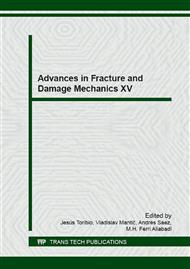[1]
F. Caputo, G. Lamanna, A. De Luca, V. Lopresto. Numerical simulation of LVI test onto composite plates. AIP Conference Proceedings 2014; 1599: 334-337.
DOI: 10.1063/1.4876846
Google Scholar
[2]
A. Riccio, A. Sellitto. Analytical tool for the preliminary design of an adhesively bonded T joint. Key Engineering Materials 2016; 665: 285-288.
DOI: 10.4028/www.scientific.net/kem.665.285
Google Scholar
[3]
A. Riccio, M. Damiano, A. Raimondo, G. Di Felice, A. Sellitto. A fast numerical procedure for the simulation of inter-laminar damage growth in stiffened composite panels. Composite Structures 2016; 145: 203-216.
DOI: 10.1016/j.compstruct.2016.02.081
Google Scholar
[4]
A. Faggiani, B.G. Falzon. Numerical analysis of stiffener runout sections. Applied Composite Materials 2007; 14(2): 145-158.
DOI: 10.1007/s10443-007-9037-z
Google Scholar
[5]
E. Greenhalgh, M.H. Garcia. Fracture mechanisms and failure processes at stiffener run-outs in polymer matrix composite stiffened elements. Composites Part A: Applied Science and Manufacturing 2004; 35(12): 1447-1458.
DOI: 10.1016/j.compositesa.2004.05.006
Google Scholar
[6]
R. Krueger, P.J. Minguet. Analysis of composite skin-stiffener debond specimens using a shell/3D modeling technique. Composite Structures 2007: 81(1), 41-59.
DOI: 10.1016/j.compstruct.2006.05.006
Google Scholar
[7]
E. Armentani, F. Caputo, R. Esposito, G. Godono. Evaluation of energy release rate for delamination defects at the skin/stringer interface of a stiffened composite panel. Engineering Fracture Mechanics 2004; 71: 885–895.
DOI: 10.1016/s0013-7944(03)00045-6
Google Scholar
[8]
H. Hosseini-Toudeshky, B. Mohammadi, B. Hamidi, H.R. Ovesy. Analysis of composite skin/stiffener debounding and failure under uniaxial loading. Composite Structures 2006; 75(1-4): 428-436.
DOI: 10.1016/j.compstruct.2006.04.019
Google Scholar
[9]
S. Psarras, S.T. Pinho, B.G. Falzon. Design of composite stiffener run-outs for damage tolerance. Finite Elements in Analysis and Design, 2011; 47(8): 949-954.
DOI: 10.1016/j.finel.2011.03.011
Google Scholar
[10]
Abaqus Analysis, User's Manual: Volume IV. Dassault Systémes, (2011).
Google Scholar
[11]
C. Dávila, P.P. Camanho, A. Turon. Cohesive Elements for Shells. NASA/TP-2007-214869, (2007).
Google Scholar
[12]
P.P. Camanho, C.G. Dávila and D. R. Ambur. Numerical simulation of delamination growth in composite materials. NASA/TP-2001- 211041, (2001).
Google Scholar
[13]
A. Turon, C. Dávila, P.P. Camanho, J. Cost. An engineering solution for mesh size effects in the simulation of delamination using cohesive zone models. Engineering Fracture Mechanics 2007; 74(10): 1665-1682.
DOI: 10.1016/j.engfracmech.2006.08.025
Google Scholar


